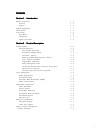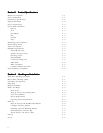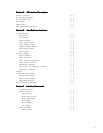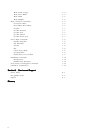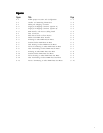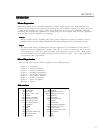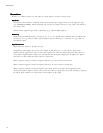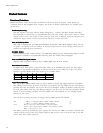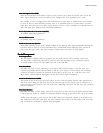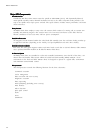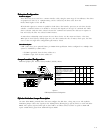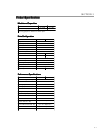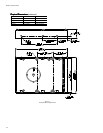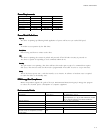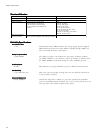
PRODUCT DESCRIPTION
2 – 2
ProductProduct
ProductProduct
Product
FeaturesFeatures
FeaturesFeatures
Features
Functional / InterfaceFunctional / Interface
Functional / InterfaceFunctional / Interface
Functional / Interface
Maxtor hard drives contain all necessary mechanical and electronic parts to interpret control signals and
commands from an AT-compatible host computer. See Section 3 Product Specifications, for complete drive
specifications.
Zone Density RecordingZone Density Recording
Zone Density RecordingZone Density Recording
Zone Density Recording
The disk capacity is increased with bit density management – common with Zone Density Recording.
Each disk surface is divided into 16 circumferential zones. All tracks within a given zone contain a constant
number of data sectors. The number of data sectors per track varies in different zones; the outermost zone
contains the largest number of data sectors and the innermost contains the fewest.
Read / Write Multiple ModeRead / Write Multiple Mode
Read / Write Multiple ModeRead / Write Multiple Mode
Read / Write Multiple Mode
This mode is implemented per ANSI ATA/ATAPI-5 specification. Read/Write Multiple allows the host
to transfer a set number of sectors without an interrupt request between them, reducing transfer process
overhead and improving host performance.
UltraDMA - Mode 5UltraDMA - Mode 5
UltraDMA - Mode 5UltraDMA - Mode 5
UltraDMA - Mode 5
Maxtor hard drives fully comply with the new ANSI Ultra DMA protocol, which greatly improves overall
AT interface performance by significantly improving burst and sustained data throughput.
Multi-word DMA (EISA Type B) - Mode 2Multi-word DMA (EISA Type B) - Mode 2
Multi-word DMA (EISA Type B) - Mode 2Multi-word DMA (EISA Type B) - Mode 2
Multi-word DMA (EISA Type B) - Mode 2
Supports multi-word Direct Memory Access (DMA) EISA Type B mode transfers.
Sector Address TranslationSector Address Translation
Sector Address TranslationSector Address Translation
Sector Address Translation
All Maxtor hard drives feature a universal translate mode. In an AT/EISA-class system, the drive may be
configured to any specified combination of cylinders, heads and sectors (within the range of the drive's
formatted capacity). Maxtor hard drives power-up in a translate mode:
MODELS CYL HD SPT MAX LBA CAPACITY
98196H8 158 816 16 63 160 086 528 81.9 GB
96147H6 119 112 16 63 120 064 896 61.4 GB
Logical Block AddressingLogical Block Addressing
Logical Block AddressingLogical Block Addressing
Logical Block Addressing
The Logical Block Address (LBA) mode can only be utilized in systems that support this form of translation.
The cylinder, head and sector geometry of the drive, as presented to the host, differs from the actual physical
geometry. The host AT computer may access a drive of set parameters: number of cylinders, heads and sectors
per track, plus cylinder, head and sector addresses. However, the drive can’t use these host parameters directly
because of zoned recording techniques. The drive translates the host parameters to a set of logical internal
addresses for data access.
The host drive geometry parameters are mapped into an LBA based on this formula:
LBA = (HSCA - 1) + HHDA x HSPT + HNHD x HSPT x HCYA (1)
= (HSCA - 1) + HSPT x (HHDA + HNHD x HCYA) (2)
where HSCA = Host Sector Address, HHDA = Host Head Address
HCYA = Host Cylinder Address, HNHD = Host Number of Heads
HSPT = Host Sectors per Track
The LBA is checked for violating the drive capacity. If it does not, the LBA is converted to physical drive
cylinder, head and sector values. The physical address is then used to access or store the data on the disk
and for other drive related operations.



